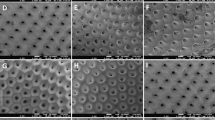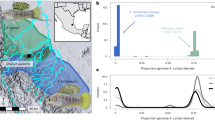Abstract
Interspecific hybrids raise a variety of developmental, reproductive, and evolutionary issues. In Sicily, geographically and chronologically distinct hybridizations between the highly differentiated Bacillus rossius and B. grandii have produced hybridogenetic strains and clonal parthenogenetic species. In northern Sicily, all-female populations of facultatively Parthenogenetic B. rossius and bisexual B. grandii benazzii co-occur and we could test their current hybridization through electrophoretic marker analyses; control crosses with allopatric males were also carried out. Hybrid female progeny percentages ranged from 0 to 74 being fewer in egg batches laid by parthenogenetic mothers than in those of amphimictic females; no difference was noticed between sympatric and allopatric pairs. F1 hybrids of both sexes proved sterile; although some eggs started cleaving, no hemiclonal or clonal progeny hatched, only rare androgenetics being obtained. In currently produced hybrids a complete disruption of gametogenesis occurs, so that genetic constraints between parental taxa appear stronger now than in the past, most likely the result of ancestor evolution.
Similar content being viewed by others
Article PDF
References
Avise, J C, Quattro, J M, and Vrijenhoek, R C. 1992. Molecular clones within organismal clones: mitochondrial DNA phylogenies and the evolutionary histories of unisexual vertebrates. In: Hecht, M. K., Wallace, B. and Maclntyre, R. J. (eds). Evolutionary Biology, vol. 26, pp. 225–246. Plenum Press, New York.
Bullini, L. 1965. Ricerche sulle caratteristiche biologiche della anfigonia e della partenogenesi in una popola-zione bisessuata di Bacillus rossius (Rossi) (Cheleutop-tera = Phasmoidea). Riv Biol, 58, 189–216.
Bullini, L. 1985. Speciation by hybridization in animals. Boll Zool, 52, 121–137.
Bullini, L. 1994. Origin and evolution of animal hybrid species. Trends Ecol Evol, 9, 422–426.
Bullini, L, and Nascetti, G. 1990. Speciation by hybridization in phasmids and other insects. Can J Zool, 68, 1747–1760.
Cimino, M C. 1972. Egg-production, polyploidization and evolution in a diploid all-female fish of the genus Poeciliopsis. Evolution, 26, 294–306.
Coyne, J A. 1994. Rules for Haldane's rule. Nature, 369, 189–190.
Darewsky, I S. 1983. Origin of the unisexuality and hybridogenous speciation in vertebrate animals. Abh Akad Wiss DDR Abt Math Naturwiss Tech, 14, 75–82.
Dawley, R M, and Bogart, J P. 1989. Evolution and ecology of unisexual vertebrates. New York State Museum Bull, 466, 1–302.
Drosopoulos, S. 1978. Laboratory synthesis of a pseudo-gamous triploid “species” of the genus Muellerianella (Homoptera, Delphacidae). Evolution, 32, 916–920.
Mantovani, B, and Scali, V. 1992. Hybridogenesis and androgenesis in the stick-insect Bacillus rossius-grandii benazzii (Insecta, Phasmatodea). Evolution, 46, 783–796.
Mantovani, B, and Scali, V. 1993. Ecological, genetic and phyletic characterization of Bacillus grandii maretimi (n. subsp.) (Insecta Phasmatodea). Vie et Milieu, 43, 241–246.
Marescalchi, O, Pijnacker, L P, and Scali, V. 1991. Cytology of parthenogenesis in Bacillus whitei and Bacillus lynceorum (Insecta Phasmatodea). Inv Repr Dev, 20, 37–43.
Moritz, C, Brown, W M, Densmore, L D, Wright, J W, Vyas, D, and Donnellan, S. et al. 1989. Genetic diversity and the dynamics of hybrid parthenogenesis in Cnemidophorus (Teiidae) and Heteronotia (Gekkonidae). In: Dawley, R. M. and Bogart, J. P. (eds). Evolution and Ecology of Unisexual Vertebrates New York State Museum Bull, 466, 87–112.
Nascetti, G, and Bullini, L. 1982. Bacillus grandii n. sp. and B. whitei n. sp.: two new stick-insects from Sicily (Cheleutoptera, Bacillidae). Boll lst Entomol Univ Bologna, 36, 245–258.
Nascetti, G, Bianchi Bullini, A P, and Bullini, L. 1985. Speciation by hybridization in the stick insects Bacillus whitei and B. lynceorum (Cheleutoptera, Bacillidae). Atti Assoc Genet Ital, 31, 135–136.
Quattro, J M, Avise, J C, and Vrijenhoek, R C. 1992. Mode of origin and sources of genotypic diversity in triploid fish clones (Poeciliopsis: Poeciliidae). Genetics, 130, 621–628.
Scali, V. 1968. Biologia riproduttiva del Bacillus rossius (Rossi) nei dintorni di Pisa con particolare riferimento all'influenza del fotoperiodo. Atti Soc Tose Sc Nat Mem, 75, 108–139.
Scali, V, and Tinti, F. 1992. Rapid assessment of maturation stage and reproductive mode in centrolecytic eggs of stick insects (Phasmatodea) using DAPI stain. Biotech Histochem, 67, 356–359.
Scali, V, Tinti, F, and Mantovani, B. 1992. From bisexual to unisexual organisms: the case of Bacillus whitei (Insecta Phasmatodea). In: Dallai, R. (ed). Sex Origin and Evolution. Selected Symposia and Monographs UZI, pp 353–368. Mucchi, Modena.
Scali, V, Tinti, F, Mantovani, B, and Marescalchi, O. 1995. Mate recognition and gamete cytology features allow hybrid species production and evolution in Bacillus stick insects. Boll Zool, 62, 59–70.
Schartl, M, Indrajit, N, Schlupp, I, Wilde, B, Epplen, J T, Schmid, M, and Parzefall, J. 1995. Incorporation of subgenomic amounts of DNA as compensation for mutational load in a gynogenetic fish. Nature, 373, 68–71.
Schultz, R J. 1973. Unisexual fish: laboratory synthesis of a “species”. Science, 179, 180–181.
Sokal, R R, and Rohlf, F J. 1981. Biometry, 2nd edn. Freeman, San Francisco.
Tinti, F, and Scali, V. 1992. Genome exclusion and gametic DAPI-DNA content in the hybridogenetic Bacillus rossius-grandii benazzii complex (Insecta Phasmatodea). Mol Repr Dev, 33, 235–242.
Tinti, F, and Scali, V. 1995. Allozymic and cytological evidence for hemiclonal, all-paternal and mosaic offspring of the hybridogenetic stick insect Bacillus rossius-grandii grandii. J Exp Zool, 273, 149–159.
Tinti, F, and Scali, V. 1996. Androgenetics and triploids from an interacting parthenogenetic hybrid and its ancestors in stick insects. Evolution, 50, 1251–1258.
Wade, M J, and Johnson, N A. 1994. Reproductive isolation between two species of flour beetles, Tribolium castaneum and T. freemani: variation within and among geographical populations of T. castaneum. Heredity, 72, 155–162.
Author information
Authors and Affiliations
Rights and permissions
About this article
Cite this article
Mantovani, B., Tinti, F., Barilani, M. et al. Current reproductive isolation between ancestors of natural hybrids in Bacillus stick insects (Insecta: Phasmatodea). Heredity 77, 261–268 (1996). https://doi.org/10.1038/hdy.1996.140
Received:
Issue date:
DOI: https://doi.org/10.1038/hdy.1996.140



